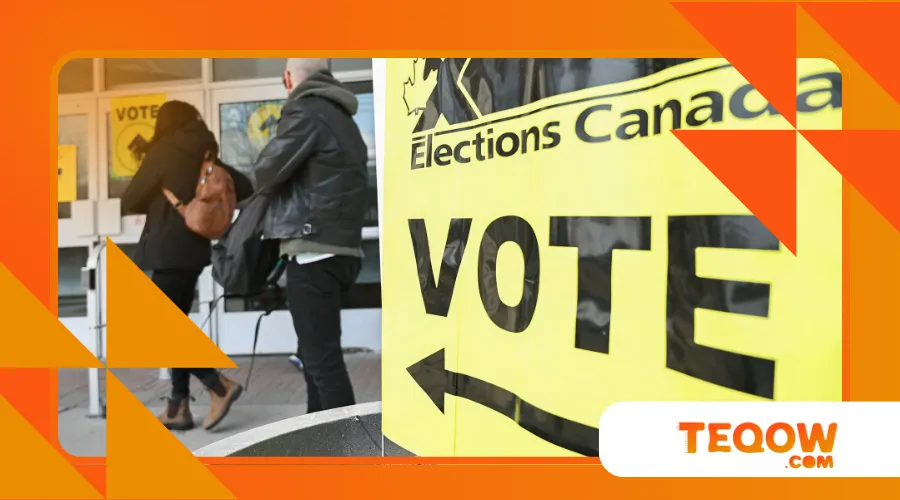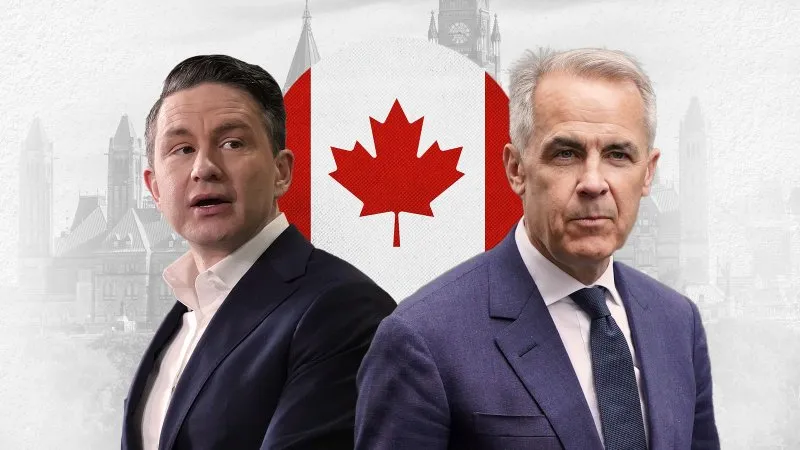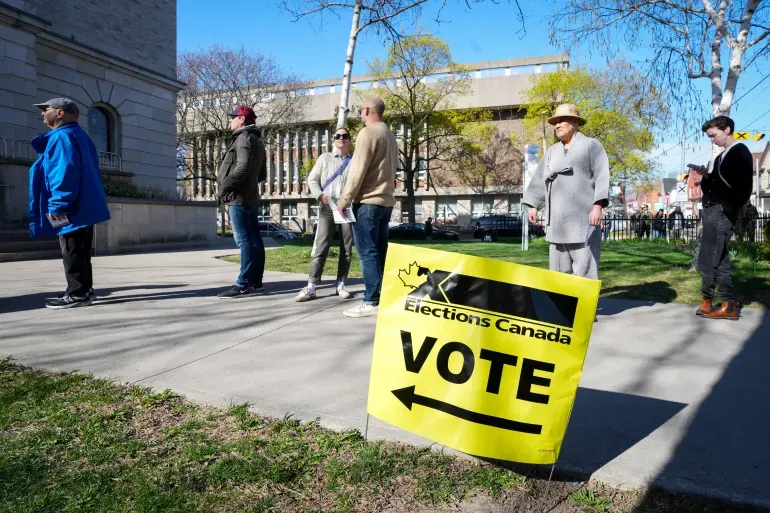Canadians Vote in Pivotal Election Overshadowed by US Tariffs and Annexation Threats

Today, Canadians vote in a pivotal election that could redefine the nation’s future, as U.S. tariffs and annexation threats cast a long shadow over the campaign.
The stakes are monumental, with voters choosing between Liberal Prime Minister Mark Carney’s promise of economic stability and Conservative leader Pierre Poilievre’s vision of reform after nearly a decade of Liberal governance.
President Donald Trump’s aggressive trade policies and inflammatory rhetoric about absorbing Canada as the “51st state” have ignited a surge of nationalism, transforming this election into a referendum on sovereignty and resilience.
This isn’t just a choice between parties—it’s a battle for Canada’s identity in a turbulent world.
What will it mean to be Canadian when the ballots are counted?
The election results could set a precedent for future relations with the U.S., influencing how Canada navigates its sovereignty amid external pressures.
This moment in history is not just about political leadership; it’s about the essence of Canadian identity and its resilience in the face of adversity.
A Campaign Shaped by External Pressures
The road to this election has been anything but ordinary.
Trump’s decision to impose 25% tariffs on Canadian steel and aluminum, effective March 12, 2025, sent shockwaves through the economy.
These measures, coupled with threats of further tariffs on cars and pharmaceuticals, jeopardize over 75% of Canada’s exports, which flow to the U.S. annually.
The Angus Reid Institute found that 55% of Canadians feel “angry” about these trade hostilities, a sentiment that has unified voters across political lines.
This isn’t a distant policy debate—it’s a direct assault on livelihoods, from Alberta’s oil fields to Ontario’s auto plants.
Mark Carney, a former Bank of England governor, stepped into the Liberal leadership in March 2025, inheriting a party battered by declining approval under Justin Trudeau.
His pitch is rooted in expertise: a steady hand to navigate global markets and counter Trump’s economic bullying.
Carney’s campaign rallies, like one in Montreal on March 27, have leaned heavily on defiance, with slogans like “Canada is not for sale.”
He’s promised to diversify trade, boost domestic manufacturing, and renegotiate the USMCA to shield Canada from further U.S. aggression.
Contrast this with Pierre Poilievre, whose fiery populism has electrified Conservative supporters.
Poilievre’s campaign, launched with a bold “Canada First” manifesto, focuses on slashing taxes and addressing domestic woes like housing affordability.
At a rally in Calgary, he framed the election as a chance to “break free from Liberal dependence on Washington.”
Yet, his initial reluctance to pivot from domestic issues to Trump’s threats cost him momentum, as polls shifted dramatically in the Liberals’ favor by late February.
The election campaign has thus become a battleground for the hearts and minds of Canadians, reflecting their fears and aspirations in a rapidly changing geopolitical landscape.
Nationalism as a Double-Edged Sword
Think of Canada’s current mood as a forest fire: sparked by Trump’s provocations, it’s spreading fast, warming hearts with pride but risking uncontrolled destruction.
The “Buy Canadian” movement has exploded, with grocery stores in British Columbia reporting a 20% spike in local product sales since February.
Social media buzzes with hashtags like #StandWithCanada, and even sports arenas have become battlegrounds, with fans booing the U.S. anthem at hockey games.
This patriotic fervor has bolstered Carney’s Liberals, who’ve surged from a low of 19% support in January to a solid lead by April, according to Ekos Research.
Yet, nationalism cuts both ways.
Poilievre has tapped into a different strain, one that distrusts globalist elites like Carney.
His supporters, particularly in rural Alberta, see the election as a chance to reject external influence—whether from Washington or Ottawa’s cosmopolitan corridors.
This divide raises a question: can Canada harness its unity without fracturing along regional or ideological lines?
The challenge lies in balancing national pride with the need for cooperation and understanding among diverse communities.
As Canadians grapple with their identity, the election becomes a litmus test for the nation’s ability to unite in the face of external threats.
| Key Campaign Promises | Candidate | Economic Policy | Trade Strategy | Domestic Focus |
|---|---|---|---|---|
| Mark Carney | Diversify trade, boost clean energy | Renegotiate USMCA, maintain retaliatory tariffs | Build homes, factories for self-reliance | |
| Pierre Poilievre | 15% income tax cut, deregulate housing | Accelerate free trade talks with U.S. | Address cost-of-living, crime |
+ Liberals Promise C$5 Billion Investment in Trade Diversification Fund

The Economic Stakes: A Nation on Edge
Canada’s economy is a tightrope walker facing gusting winds.
Trump’s tariffs threaten to disrupt supply chains, particularly in the auto sector, which employs 125,000 Canadians directly.
A hypothetical example illustrates the risk: Sarah, a Windsor assembly line worker, faces layoffs if U.S. tariffs make Canadian-made cars too costly.
Her story mirrors thousands, as small businesses and exporters brace for higher costs.
Carney’s pledge to “build things in this country again” aims to counter this, with plans for new factories and energy projects.
But can these materialize fast enough to offset immediate pain?
Poilievre, meanwhile, argues that tax cuts will put money back in pockets, stimulating growth.
His plan to axe sales tax on new homes could help young families like the fictional Chens in Vancouver, who’ve been priced out of the market.
Yet, critics warn his policies risk inflation, especially if trade disruptions drive up consumer prices.
A February 2025 Harris Poll noted that 60% of Americans believe tariffs will raise U.S. prices, suggesting a ripple effect that could hit Canada hard.
This economic uncertainty creates a precarious environment for voters, forcing them to consider not just immediate impacts but long-term consequences of their choices.
| Economic Impact of U.S. Tariffs | Sector | Tariff Rate | Potential Job Losses | Export Value at Risk |
|---|---|---|---|---|
| Steel & Aluminum | 25% | 15,000 | $12 billion | |
| Automotive | 25% (proposed) | 50,000 | $60 billion | |
| Energy | 10% | 5,000 | $80 billion |
A Referendum on Leadership Style
Voters aren’t just choosing policies—they’re picking a captain for stormy seas.
Carney’s cerebral approach, honed at global institutions, contrasts with Poilievre’s street-fighter energy.
Carney’s October podcast with Nate Erskine-Smith, where he touted his connections to “the world’s largest companies,” positioned him as a global player.
But this risks alienating voters who see him as detached from everyday struggles.
Poilievre, by contrast, thrives on relatability, with viral videos slamming “Liberal elites” for rising grocery prices.
The campaign’s final days underscored this divide.
A tragic car-ramming incident in Vancouver on April 27, killing 11, forced both leaders to pause campaigning.
Carney’s somber address focused on unity, while Poilievre emphasized community resilience.
These moments revealed their cores: Carney as the steady diplomat, Poilievre as the passionate advocate.
The stark contrast in their leadership styles presents voters with a choice not just of policy, but of values and vision for the future.
As Canadians weigh their options, the question remains: who do they trust to navigate the challenges ahead?

++ Liberals Pledge Faster Recognition of Foreign Credentials for Healthcare and Skilled Trades
The Global Context: Canada’s Place in the World
Beyond domestic concerns, Canadians vote in a pivotal election with global eyes watching.
Trump’s rhetoric echoes historical U.S. attempts to pressure Canada, like the 1890 McKinley Tariff, which backfired by galvanizing Canadian resistance.
Today, allies like the EU and Japan are monitoring Canada’s response, as a weakened USMCA could disrupt global trade.
Carney’s experience at the Bank of England gives him leverage in these circles, but Poilievre’s push for energy independence could resonate with resource-hungry partners.
The election also tests Canada’s diplomatic agility.
Trump’s April 2 executive order on tariffs framed them as a response to fentanyl and immigration, issues Canada has addressed with a $1.3 billion border security plan.
Yet, his persistence suggests deeper motives—perhaps a negotiation tactic, as some Americans believe, per a University of Michigan poll.
Whoever wins must balance defiance with pragmatism, as Mexico’s President Sheinbaum has done by making concessions to Trump.
The outcome of this election could have lasting implications for Canada’s role on the global stage, influencing trade relationships and international partnerships for years to come.
For further insights into Canada’s international relations, visit Global Affairs Canada.
The Voter’s Dilemma: Fear vs. Hope
As Canadians vote in a pivotal election, they face a stark choice: fear-driven unity under Carney or hope-fueled change with Poilievre.
The Liberals have capitalized on Trump’s shadow, framing themselves as Canada’s shield.
But Poilievre’s message—that Canada can thrive by unshackling its potential—resonates with those tired of external threats dictating the narrative.
A record 7.3 million early votes signal intense engagement, driven by both anger and aspiration.
This election isn’t just about 2025—it’s about the next decade.
Will Canada double down on global integration, or turn inward to rebuild?
The answer lies in the ballots cast today, as Canadians vote in a pivotal election that will echo far beyond their borders.
The decisions made in this election will not only shape the immediate political landscape but also set the tone for Canada’s future direction and its relationship with the world.
Conclusion: A Nation at a Crossroads
As polling stations close in Newfoundland and Labrador, Canadians vote in a pivotal election that transcends party lines.
Trump’s tariffs and annexation threats have forced a reckoning, awakening a nationalism that could either unite or divide.
Carney and Poilievre offer distinct paths: one of calculated resilience, the other of bold reinvention.
Whatever the outcome, this election will shape Canada’s soul, its economy, and its place in a fractured world.
The world watches, and so do we—because when Canadians vote in a pivotal election, they’re not just choosing a leader; they’re defining a legacy.
The consequences of this election will resonate for years, influencing not only domestic policy but also Canada’s standing on the global stage.
As Canadians cast their votes, they hold the power to determine the future trajectory of their nation amidst unprecedented challenges.
